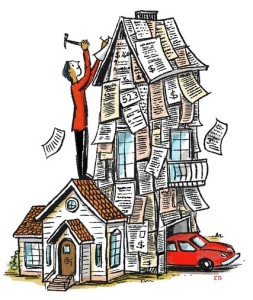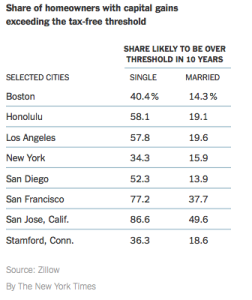By: Robert Neubecker
June 5th, 2015
The New York Times

A tax time bomb is ticking for an increasing number of people who have been lucky enough to see big gains in the values of their homes. This is especially true in and around cities like New York, Los Angeles, San Francisco, Boston and San Diego, where home prices have increased smartly over the last decade or two. There, single homeowners with gains of over $250,000 and married people who have notched at least $500,000 could end up paying federal tax of as much as 23.8 percent on real estate gains over those amounts when they sell. Additional state taxes loom for some of them as well. If you are in this situation or think you may be just when you need those gains to live on in your old age, there is a small pile of paperwork you need to start filing away now and keep until you sell the home. That paperwork is for all the improvements you have made to your home. The cost of those improvements counts against the gain. Even a single remodeling can offset the gains by well into the six figures. Just how many people might this tax affect? I asked the number crunchers at the real estate website Zillow to take a look. Currently, they believe that 3.8 percent of the homes around the country are already in the tax zone for single people and that 1.2 percent have reached the threshold for married couples. The number of people affected is much higher, however, in expensive cities. In San Francisco, for instance, a quarter of all homes have a gain of over $250,000, thus having a tax impact on any single owners. More than one-third of the homes in San Jose, Calif., do, too. For married people, the numbers become more frightening when you assume a 3.5 percent annual increase in home prices and look ahead 10 years. By then, 15.9 percent of the homes in the New York City area could be in for a tax bill if they’re owned by married people, along with 19.6 percent of the homes in Los Angeles. Those numbers could be higher if real estate prices rise more quickly. They could also be lower, given that Zillow, in its projections, assumed that the homeowners were not moving to other houses or making improvements in that period. Their tax bills might also be higher if, like many people, they failed to realize that they should be keeping their receipts and closely tracking this potential tax. Now that you are no longer among the uninformed, however, where should you start with the record-keeping extravaganza, in case you find yourself among those with outsize gains on your home?
The bible for all of this is Internal Revenue Service Publication 523: Selling Your Home. On page 12, you will find the I.R.S.-approved list of things that you can, in effect, subtract from your gain before you determine whether it’s below or above the $250,000/$500,000 limit. Homeowners usually pay no capital gains taxes on any amount below those numbers. Also, you generally have to have been living in the home for at least two of the previous five years before the sale to receive the waiver on the taxes if you are below those thresholds.
On that list in Publication 523, you will find improvements and additions of all sorts, including decks and patios; landscaping, including sprinkler systems; pools; a new roof or siding; insulation; and kitchen remodeling. Some smaller and perhaps surprising things are there, too: installation of utility services, which could include any fiber charges from Verizon for FiOS or money you paid to the person who hard-wired your Apple TV to your cable modem. Each additional electrical outlet should count, too. Also, you can add in many legal, title and recording fees (plus transfer and certain other taxes) from your closing.
Repairs don’t count, and this gets tricky. Most people have to paint, so that’s generally a repair. Refinishing wood floors is maintenance, too, though installing new ones is an improvement that ought to count in your total.
Built your house from the ground up? Your list includes the cost of the land, all materials and any money you paid to contractors and their laborers plus architect fees. If you swung a hammer yourself, tough luck: Your hard work counts for nothing in the eyes of the eyes of the I.R.S. Ditto your friends who pushed up walls in exchange for pizza and beer.
If you live in a condominium or cooperative building or a community with homeowners’ association fees, some of your monthly charges and many of your special assessments may also count. Ask the managing agent about this, and require the building or community’s accountant to offer this per capita figure each year in a format that allows you to file it away and keep it.
The catch here is that you need receipts for every one of these things. Nobody tells you this at the closing table. Or if they do, you don’t hear it because you’re freaking out about the cost of your home or too excited to go check out tile samples after signing 100 closing documents. Sober-minded individuals tend not to consider the possibility of a big gain at some later date, either. After all, you’re not supposed to think of a home as an investment, even if the I.R.S. does in this particular context.
But you do need to keep the paperwork, long after you have discarded your older tax returns. The website costbasis.com even reminds us all that certain thermal receipts will fade away over time. It’s best to photocopy them or take digital photos and put them away somewhere in the cloud.
Because we are talking about taxes here, there will be exceptions, carveouts and exceptions to the carveouts issued in I.R.S. private letter rulings and whatnot. If you fall into any of the following categories, it’s probably best to consult a tax professional: widows or widowers, members of the military, newly remarried couples who already have homes, people who have moved for job transfers, nursing home residents who have kept the homes they used to live in, people who sold a home before 1997 and rolled their capital gain over into the home they live in now and people who rebuilt after a fire, flood or other similar event.
Ditto if you inherited the home or got it as a gift and also if you rented it out at any point or used it for business. People who received the first-time home buyer’s credit in 2008 should also dig deeper.
A few other quirks that can help or hurt. If you have a capital loss in your past, you can use it to offset the gain you may receive from your home. Jean-Luc Bourdon, a certified public accountant with a personal finance specialization at BrightPath Wealth Planning in Santa Barbara, Calif., told me about a client who panicked in 2008 and sold investments at a large loss. Later, when he sold his home for a large gain, he was able to offset the gain with the losses he took in the stock market.
Eva Rosenberg, an enrolled agent who maintains the taxmama.com site, warns of a common problem she sees in states like New York and California, where prices have risen a fair bit. People borrow against their homes, spending the money and draining the equity. Then, when they sell and receive, say, $50,000 after repaying their mortgage and home equity loans, they think that’s their capital gain. But it isn’t, and sometimes their tax bill is actually much higher than that $50,000.
So could the rules change, or might lawmakers at least index the $250,000 and $500,000 figures to inflation? It could happen, most likely in a Republican administration. But it’s the sort of thing that only benefits the truly lucky.
I was tempted to use the word rich in the previous sentence, but Mr. Bourdon told me not to. “It isn’t true anymore,†he said. “If you’ve owned nearly any home here in Santa Barbara long enough, you could have a taxable gain on your home.â€
If nothing else changes, his assessment will be increasingly accurate in many other areas of the country as well.

Published by